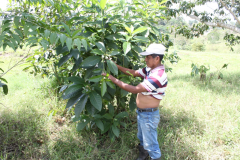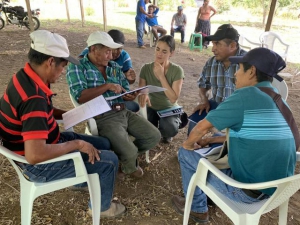By
Connor Yearsley
 In
early June 2020, Domingo Choc Che, 55, a Q’eqchi’ Maya spiritual guide and
traditional medicine expert, was brutally tortured and murdered after a group
of people seized him from his home in Chimay, Guatemala.1 In
early June 2020, Domingo Choc Che, 55, a Q’eqchi’ Maya spiritual guide and
traditional medicine expert, was brutally tortured and murdered after a group
of people seized him from his home in Chimay, Guatemala.1
The
abductors accused Choc Che of witchcraft and performing a ceremony on a grave,
beat him for more than 10 hours, doused him with gasoline, and set him on fire.
A video shows Choc Che on fire, running, and asking for help before collapsing.
Police arrested two men and two women in connection with his murder.1 One
man was released because of lack of proof, and the other three await trial,
which is set to begin in October.
Choc
Che, who was affectionately called “Tata (‘Grandfather’ or ‘Elder’) Domingo,”
participated in several research projects to conserve traditional Maya knowledge.
At the time of his death, he was one of 30 participants in a project to
document traditional medicinal plants in the Petén department of Guatemala.
Launched in May 2019, this ongoing initiative is a collaboration among
University College London (UCL), Zurich University, and Universidad del Valle
de Guatemala (UVG).1
In The
Guardian, Michael Heinrich, PhD, UCL professor of ethnopharmacology and
pharmacognosy, was quoted as saying that Choc Che’s murder “is an atrocity, a huge violation of the
most basic human rights, and leaves one with a feeling of helplessness.”1
For some people, his
death is a harsh reminder of Guatemala’s 36-year genocidal civil war, which
lasted from 1960 to 1996. During that time, more than 200,000 people were
killed and an additional 45,000 disappeared. Eighty percent of victims during
the war were indigenous. The 1996 Guatemalan peace accords recognized the
rights of indigenous peoples to their traditions, but prejudices and persecution
continue.1
Below is a Q&A
with Mónica Berger Gonzalez (MBG), PhD, director of the Unit of Medical
Anthropology at UVG, and Heinrich (MH), both of whom worked with Choc Che. The
responses have been edited for ABC style and are based on email conversations
with Gonzalez and Heinrich on August 27 and 28, 2020, respectively.
Can you describe Domingo Choc Che as a person? What was he like?
MBG: Domingo was a kind and quiet man. He
kept to himself and was most comfortable walking in the forest to collect
plants. He was wise and full of love for nature, animals, and people. He took
his job as an ajilonel (a Maya traditional herbalist-healer) seriously,
though he never promoted himself as a healer. He used to say that healing and
plant knowledge were gifts given by the Creator, and one should be humble about
them. He treated everyone who came to see him. He was humble. In meetings, he
waited for everyone to talk and only at the end asked questions, which were often
profound. Over the years, he took care of many people with afflictions and
worked as a support counselor for victims of the armed conflict who needed
emotional and spiritual support.
Can you describe Choc Che’s contributions to the
project, especially those related to medicinal plants?
MBG: Along with 15 other Q’eqchi’
herbalists, Domingo’s role involved thoroughly documenting his daily healing
practice, including details about the types of patients he treated, diagnoses,
and associated  treatments. After six months of this documentation, he [went]
with our team of biologists into the forest to collect the medicinal plants
that were listed in his treatments. He was trained on modern methods of
ethnobotanical collection and herborization [the collection and study of
plants] and helped gather all the samples to be sent to UVG’s herbarium for
identification. He was a lover of the forest and shared his knowledge openly
with our anthropology and biology students. He shared not only medical
information but many details about the plants’ growth, energy, and spiritual
uses in Maya practice. He was open to questions and often shared his plans for
creating a medicinal plant garden to help rescue species at risk of
disappearing due to habitat destruction, etc. He was part of an effort to build
a popol jay, the “House of the Council,” a place with a medicinal plant
garden where new generations of ajilonel could be trained. treatments. After six months of this documentation, he [went]
with our team of biologists into the forest to collect the medicinal plants
that were listed in his treatments. He was trained on modern methods of
ethnobotanical collection and herborization [the collection and study of
plants] and helped gather all the samples to be sent to UVG’s herbarium for
identification. He was a lover of the forest and shared his knowledge openly
with our anthropology and biology students. He shared not only medical
information but many details about the plants’ growth, energy, and spiritual
uses in Maya practice. He was open to questions and often shared his plans for
creating a medicinal plant garden to help rescue species at risk of
disappearing due to habitat destruction, etc. He was part of an effort to build
a popol jay, the “House of the Council,” a place with a medicinal plant
garden where new generations of ajilonel could be trained.
How difficult and important is it to continue the project after
what happened to him?
MBG: The Maya elders
continue to be persecuted and confused as “evil witches,” due to widespread
lack of knowledge about Maya medicine and spirituality. To address the fear
caused by ignorance, we more than ever need to continue efforts to communicate
to society in general that the knowledge of an ajilonel is actually Maya
science. In Maya cosmogony, ignorance is the first “sin” of the Wuqub’ Qaqix
(the seven veils that keep us from being at peace with the Creator, according
to Maya spirituality). It was ignorance, lack of knowledge, and fear of what we
do not understand that led people to burn Tata Domingo. Therefore, it is
important to bring to light the depths of this ancient medical system with
respect, while honoring and crediting the elders. Research is imperative, and communication
of the results with respect for intellectual property has to be our goal.
MH: We need much more national and international
recognition of the tremendous contributions of traditional knowledge holders
and other people in local communities. Therefore, it is crucial to continue the
project, and we will.
What should people know about this crime? What should they learn
from it?
MBG: People need to
know that ignorance is not harmless, prejudices kill, and fanaticism without
compassion is dangerous. Religious freedom is not a given, racism shows in many
forms, and it takes everyone to end cycles of hatred, mistrust, and ignorance.
A society where this type of crime can happen has to heal and learn, and this
is a collective effort. This is not only the fault of those who committed this
crime. It is a mirror of our society’s blindness to the value of other
epistemic systems and sources of knowledge. We are still suffering from minds
embedded in colonialism.
MH: This was in no way the first, nor will it be the
last, murder of this type. There remains a level of marginalization and
exploitation that needs to be overcome, and not only in Guatemala. A few weeks later, in late June, a group of Ikoots (Huave) men and
women were murdered in Oaxaca, Mexico, due to territorial conflicts.2
What needs to change to prevent a crime like this
from happening again?
MBG: We need to conduct systematic research in transdisciplinary
formats in which Maya ajilonel are co-researchers. We need peer-reviewed
papers, but we also need information published in Spanish and in many formats
for a wide audience. People need to know who Domingo was and that with his
death a library was burned to the ground.
MH: Change is complex, and there is no short-term
solution. I hope that projects like ours will help in the long run. We need to ensure
that rights are defended, all points that have been made by many activists,
scientists, and others. The global understanding of the current situation and
challenges in rural regions, especially for indigenous people but also for
national and international migrants, is very limited and often does not reflect
the social and cultural realities. We also need support to develop livelihoods
for people in these regions. These regions are no longer pristine forests, and
we must empower communities to develop local, sustainable economies that
respect traditions and biodiversity.
Why do you think this happened?
MBG: This is multicausal. It is an
impoverished area with few services, an absent state, not enough food, jobs,
and education, and too much intolerance.
MH: The project was not the
trigger, but Don Domingo’s knowledge and ability to heal was a cause of fear,
hate, and disdain. It is crucial to ensure dignity, tolerance, and mutual
respect of diversity.
Image credits (top to bottom): Domingo Choc Che. Image courtesy of Mónica Berger Gonzalez
Domingo (in red and black) observes a discussion. Image courtesy of Mónica Berger Gonzalez
References
- Abbott
J. Outrage as Guatemalan Maya spiritual guide is tortured and burned alive. The
Guardian website. June 10, 2020. Available at: www.theguardian.com/world/2020/jun/10/guatemalan-maya-spiritual-guide-tortured-burned-alive. Accessed September
4, 2020.
- Serious
acts of violence against community in San Mateo del Mar, Oaxaca. PBI Mexico
website. Available at: pbi-mexico.org/news/2020-07/serious-acts-violence-against-community-san-mateo-del-mar-oaxaca. Accessed September
4, 2020.
|